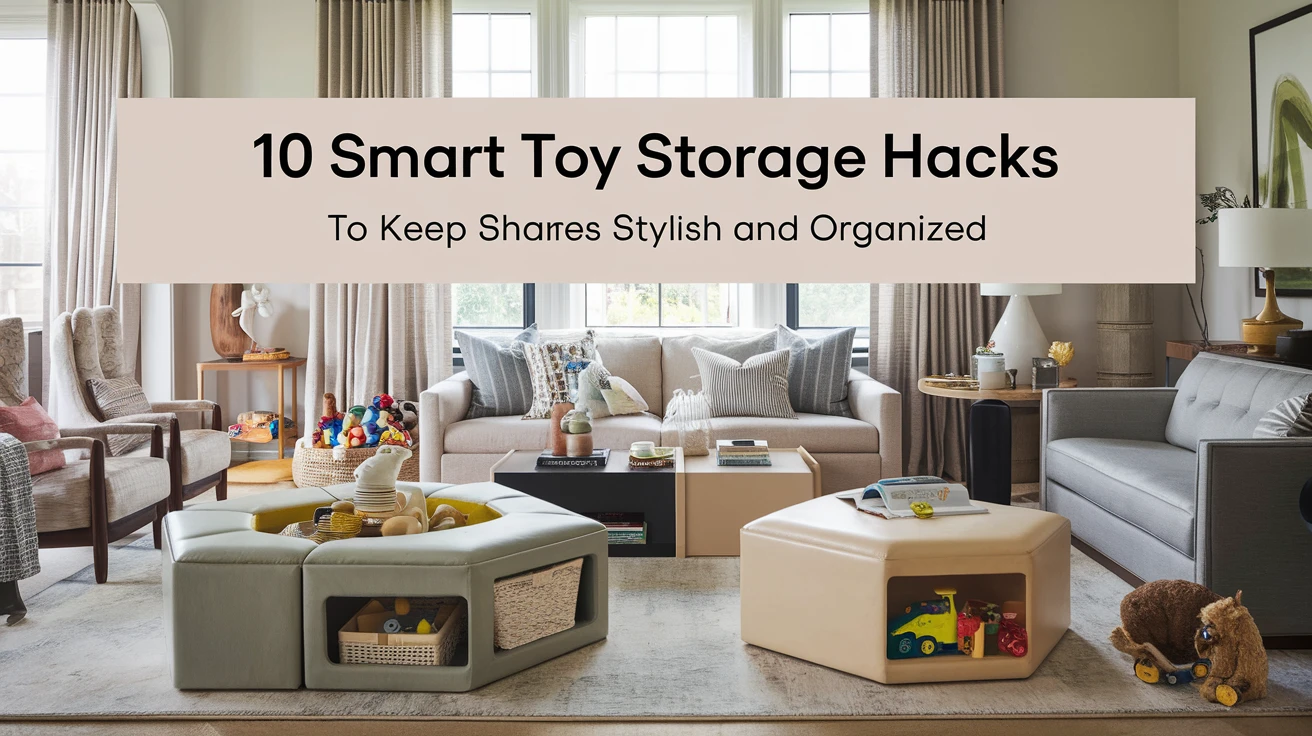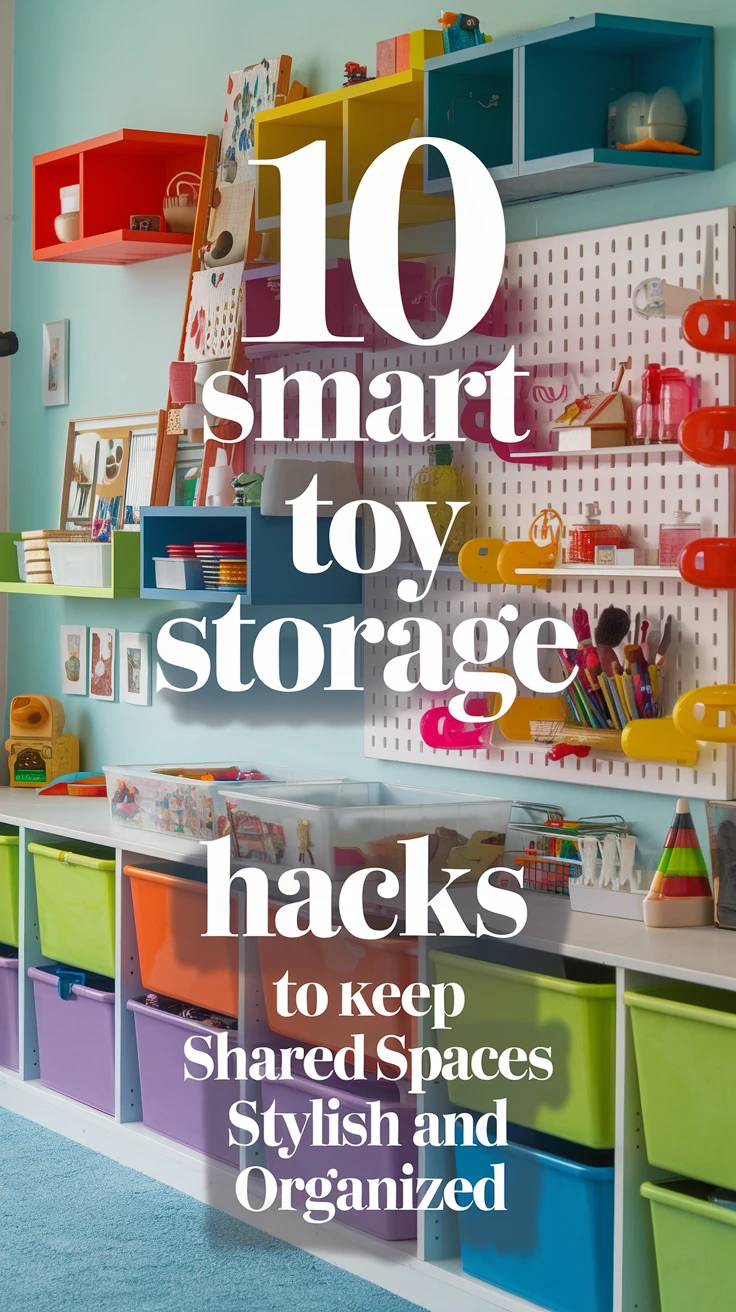
Living in a shared space with children can feel like navigating a perpetual obstacle course of toys, games, and craft supplies. Whether you’re dealing with a combined living-playroom or trying to maintain order in a compact apartment, the challenge of keeping toys organized while preserving your home’s aesthetic appeal is real. As someone who’s transformed countless chaotic spaces into harmonious havens, I’ve learned that the key lies not in hiding away childhood joy but in finding clever ways to integrate it into your home’s design. In this guide, I’ll share 10 practical and stylish toy storage solutions that have worked wonders in shared spaces, helping families maintain both their sanity and their style.
1. Multi-Purpose Storage Furniture: Style Meets Function
When I first tackled the challenge of toy storage in my own living room, I discovered that multi-functional furniture was a game-changer. Instead of traditional toy boxes that stick out like sore thumbs, consider these dual-purpose options:
| Furniture Item | Storage Capacity | Style Factor |
|---|---|---|
| Ottoman with Storage | Medium (15-20 toys) | High – Blends with any decor |
| Coffee Table with Compartments | Large (25-30 toys) | High – Centerpiece worthy |
| Window Bench Storage | Extra Large (40+ toys) | High – Creates cozy nook |
Pro tip: Look for pieces with soft-close hinges to prevent pinched fingers and items that match your existing decor for seamless integration.
2. Vertical Storage Solutions: Making Use of Wall Space
One of my biggest organizational epiphanies came when I started thinking vertically. Wall space is often underutilized, yet it offers enormous potential for toy storage without sacrificing floor space. Here’s how to maximize your vertical storage:
– Install floating shelves at various heights
– Use pegboard systems for flexible storage options
– Mount fabric pockets or clear organizers on doors
– Create a gallery wall with functional storage boxes
– Implement a climbing wall with storage pockets
Remember to anchor all wall-mounted storage solutions securely, especially in homes with active children. I learned this lesson the hard way after a shelf incident that, thankfully, only resulted in scattered stuffed animals!
3. Hidden Storage Gems: Out of Sight, Not Out of Mind
After years of trial and error, I’ve discovered some ingenious hidden storage solutions that keep toys accessible but invisible when not in use:
| Hidden Storage Spot | Best For | Accessibility Level |
|---|---|---|
| Under-Couch Drawers | Board Games, Books | Easy |
| Hollow Ottomans | Stuffed Animals, Blocks | Very Easy |
| Behind-Door Organizers | Art Supplies, Small Toys | Moderate |
The key is creating designated spots that children can easily access and, more importantly, return items to independently.
4. DIY Storage Solutions on a Budget
Sometimes the most effective storage solutions don’t require a big budget. Here are some creative DIY options I’ve implemented:
– Painted cardboard boxes with decorative paper
– Fabric-covered diaper boxes for stylish shelf storage
– Repurposed shoe organizers for small toy collections
– Custom-built rolling crates with casters
– Upcycled wooden crates mounted on walls
The best part about DIY solutions is that you can customize them to match your decor while teaching children about sustainability and creativity.
5. The Power of Toy Rotation Systems
Implementing a toy rotation system revolutionized our shared space management. Here’s my tried-and-true method:
1. Divide toys into categories
2. Create themed boxes or containers
3. Keep out 25% of toys at a time
4. Rotate weekly or bi-weekly
5. Store excess toys in labeled bins
This system not only reduces clutter but also keeps children more engaged with their toys, as each rotation feels like getting new ones.
6. Aesthetic Organization: Beautiful and Practical
Who says toy storage can’t be Instagram-worthy? Through careful curation and creative solutions, I’ve found ways to make toy storage part of the room’s design:
– Use coordinated baskets and bins in your color scheme
– Select clear containers for visually pleasing toy displays
– Incorporate decorative labels that complement your decor
– Choose storage furniture that doubles as art pieces
– Create designated “toy corners” with style
The goal is to make the storage solutions so attractive that they enhance rather than detract from your space’s overall aesthetic.
7. Kid-Friendly Storage Solutions
For storage solutions to work long-term, they need to be kid-friendly. I’ve found these approaches most successful:
– Low-height open shelving for easy access
– Picture labels for non-readers
– Lightweight bins that small hands can manage
– Clear containers for visual toy identification
– Simple systems that make cleanup fun
Remember, the more independent children can be with their toy storage, the more likely they are to maintain it.
8. Small Space Storage Strategies
In compact living areas, every inch counts. These space-maximizing strategies have proven invaluable:
| Strategy | Space Saved | Implementation Difficulty |
|---|---|---|
| Over-door organizers | 5-10 sq ft | Easy |
| Under-bed storage | 15-20 sq ft | Medium |
| Corner shelving units | 8-12 sq ft | Medium |
9. Smart Decluttering Methods
Regular decluttering is essential for maintaining organized shared spaces. Here’s my proven approach:
– Monthly toy purges with children’s involvement
– One-in-one-out rule for new toys
– Regular assessment of broken or unused items
– Donation schedule for outgrown toys
– Storage limits to prevent overflow
Teaching children about decluttering early helps them develop lifelong organizational skills.
10. Daily Maintenance Tips for Lasting Organization
The secret to maintaining an organized shared space lies in daily habits:
1. 10-minute cleanup sessions before bedtime
2. Morning reset routines
3. Weekly quick reorganization
4. Monthly deep cleaning of storage solutions
5. Quarterly system evaluation and adjustment
Consistency is key to maintaining any organizational system long-term.
Conclusion
Creating and maintaining organized toy storage in shared spaces isn’t just about finding the right containers or systems – it’s about developing solutions that work for your family’s unique needs while preserving your home’s style and functionality. By implementing these ten strategies, you can create a harmonious space that serves both children and adults. Remember, the perfect system might take some trial and error, but the result – a clean, organized, and peaceful living space – is worth the effort.
Key Takeaways
- Multi-functional furniture and vertical storage maximize space efficiency
- Regular rotation and decluttering prevent toy overflow
- Kid-friendly systems encourage independence and maintenance
- Aesthetic considerations can blend toy storage with home decor
- Consistent daily maintenance is crucial for long-term organization
Frequently Asked Questions
-
How often should I rotate toys in a shared space?
Ideally, rotate toys every 1-2 weeks to maintain interest and prevent overwhelming the space. This timeframe can be adjusted based on your children’s ages and preferences.
-
What’s the best way to involve children in organizing their toys?
Make it fun by using picture labels, implementing a color-coding system, and turning cleanup into a game. Start with simple tasks and gradually increase responsibility as they show readiness.
-
How can I maintain toy organization in a very small space?
Focus on vertical storage, utilize hidden spaces like under-bed areas, and implement a strict rotation system. Consider multi-functional furniture and regularly declutter to prevent overflow.
-
What are the most cost-effective storage solutions?
DIY solutions like decorated cardboard boxes, repurposed containers, and homemade shelving units can be both budget-friendly and effective. Look for sales on basic storage containers and get creative with upcycling.
-
How do I prevent toy storage from looking cluttered?
Use coordinated containers, implement a color scheme, and choose storage solutions that match your decor. Regular decluttering and maintaining a rotation system also helps prevent visual overwhelm.
-
What’s the best way to label toy storage for young children?
Use a combination of pictures and words, making sure the images are clear and recognizable. Consider using color-coding for different categories of toys.
-
How can I maintain organization when we have toys for multiple age groups?
Separate toys by age group using different colored containers or zones, and keep items for older children in higher storage areas out of reach of younger siblings.
-
What should I do with seasonal or special occasion toys?
Store these items in clearly labeled containers in less accessible areas like high shelves or closets. Rotate them in during appropriate seasons or occasions.
-
How do I handle toy storage for art supplies and crafts?
Use clear, stackable containers with secure lids for small items, and implement a system where adult supervision is required for access to messier materials.
-
What’s the best way to maintain toy organization long-term?
Establish daily cleanup routines, regularly assess and adjust your storage systems, and involve all family members in maintaining organization. Consistency and regular evaluation are key to long-term success.
